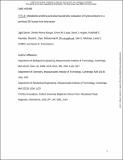Metabolite profiling and pharmacokinetic evaluation of hydrocortisone in a perfused 3D human liver bioreactor
Author(s)
Sarkar, Ujjal; Rivera-Burgos, Dinelia; Large, Emma M.; Hughes, David J.; Kodihalli, Ravindra; Dyer, Rachel Lee; Ebrahimkhani, Mohammad Reza; Wishnok, John S.; Griffith, Linda G.; Tannenbaum, Steven Robert; ... Show more Show less
DownloadSarkar - Metabolite profiling.pdf (1.287Mb)
OPEN_ACCESS_POLICY
Open Access Policy
Creative Commons Attribution-Noncommercial-Share Alike
Terms of use
Metadata
Show full item recordAbstract
Endotoxin lipopolysaccharide (LPS) is known to cause liver injury primarily involving inflammatory cells such as Kupffer cells, but few in vitro culture models are applicable for investigation of inflammatory effects on drug metabolism. We have developed a 3D human microphysiological hepatocyte-Kupffer-cell coculture system and evaluated the anti-inflammatory effect of glucocorticoids on liver cultures. LPS was introduced to the cultures to elicit an inflammatory response and assessed by the release of pro-inflammatory cytokines, IL6 and TNFα. A sensitive and specific RP-UHPLC-QTOF-MS method was used to evaluate hydrocortisone disappearance and metabolism at near physiological levels. For this, the systems were dosed with 100 nM hydrocortisone and circulated for two days; hydrocortisone was depleted to approximately 30 nM, with first-order kinetics. Phase I metabolites, including tetrahydrocortisone and dihydrocortisol, accounted for 8-10 % of the loss, and 45-52 % was phase II metabolites, including glucuronides of tetrahydrocortisol and tetrahydrocortisone. Pharmacokinetic parameters, i.e., half-life (t1/2), rate of elimination (kel), clearance (CL), and area under the curve (AUC), were 23.03 h, 0.03 h-1, 6.6x10-5 L. h-1 and 1.03 mg/L*h respectively. The ability of the bioreactor to predict the in vivo clearance of hydrocortisone was characterized and the obtained intrinsic clearance values correlated with human data. This system offers a physiologically-relevant tool for investigating hepatic function in an inflamed liver. Endotoxin lipopolysaccharide (LPS) is known to cause liver injury primarily involving inflammatory cells such as Kupffer cells, but few in vitro culture models are applicable for investigation of inflammatory effects on drug metabolism. We have developed a 3D human microphysiological hepatocyte-Kupffer-cell coculture system and evaluated the anti-inflammatory effect of glucocorticoids on liver cultures. LPS was introduced to the cultures to elicit an inflammatory response and assessed by the release of pro-inflammatory cytokines, IL6 and TNFα. A sensitive and specific RP-UHPLC-QTOF-MS method was used to evaluate hydrocortisone disappearance and metabolism at near physiological levels. For this, the systems were dosed with 100 nM hydrocortisone and circulated for two days; hydrocortisone was depleted to approximately 30 nM, with first-order kinetics. Phase I metabolites, including tetrahydrocortisone and dihydrocortisol, accounted for 8-10 % of the loss, and 45-52 % was phase II metabolites, including glucuronides of tetrahydrocortisol and tetrahydrocortisone. Pharmacokinetic parameters, i.e., half-life (t[subscript 1/2]), rate of elimination (k[subscript el]), clearance (CL), and area under the curve (AUC), were 23.03 h, 0.03 h[superscript -1], 6.6x10[superscript -5] L. h-1 and 1.03 mg/L*h respectively. The ability of the bioreactor to predict the in vivo clearance of hydrocortisone was characterized and the obtained intrinsic clearance values correlated with human data. This system offers a physiologically-relevant tool for investigating hepatic function in an inflamed liver.
Date issued
2015-04Department
Massachusetts Institute of Technology. Department of Biological Engineering; Massachusetts Institute of Technology. Department of Chemistry; Massachusetts Institute of Technology. Department of Mechanical EngineeringJournal
Drug Metabolism and Disposition
Publisher
American Society for Pharmacology & Experimental Therapeutics (ASPET)
Citation
Sarkar, U., D. Rivera-Burgos, E. M. Large, D. J. Hughes, K. C. Ravindra, R. L. Dyer, M. R. Ebrahimkhani, J. S. Wishnok, L. G. Griffith, and S. R. Tannenbaum. “Metabolite Profiling and Pharmacokinetic Evaluation of Hydrocortisone in a Perfused 3D Human Liver Bioreactor.” Drug Metabolism and Disposition (April 29, 2015).
Version: Author's final manuscript
ISSN
1521-009X
0090-9556